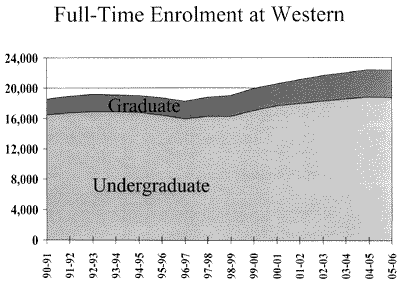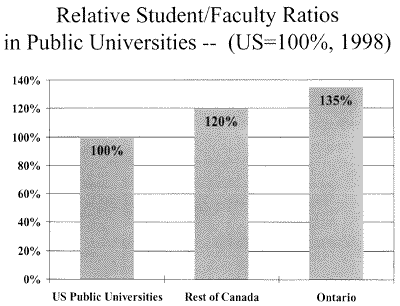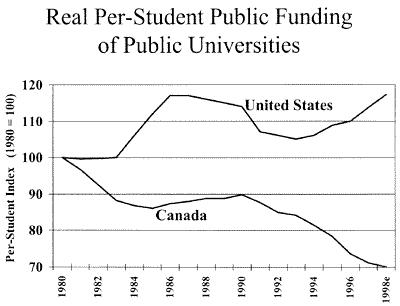VIII. Strategic Issues: Size, Resources, and Quality
Western’s mission of leadership and excellence requires that the University find the right balance between the size of its student population and the resources which it can reasonably expect to secure from public and private sources. Our strategic focus is on quality rather than quantity. Moreover, our desire to maintain a community of scholars on a campus with a significant residential component to student life sets a limit on how large Western can become. Western is already a large university, with some 23,000 Full-Time Equivalent students (FTEs) and annual admissions of full-time students of about 4,300. There are an additional 4,000 FTEs at the three Affiliated Colleges who receive Western degrees at graduation. To maintain its quality of education and the residential nature of the student experience, Western desires to limit its future expansion.At the same time, however, we recognize our role in providing access to university education for the people of London and Southwestern Ontario as the province approaches a peak in first-year admissions in 2003 and 2004. With the elimination of the OAC high school year (Grade XIII), Ontario faces the challenge of a double cohort: those who began high school in 1998 under the five-year program will graduate in the same year, 2003, with those who began in 1999 with the new four-year program. Western and its three Affiliated Colleges have committed, subject to full public funding of the additional students, to increase enrolment on our campus by over 3,400 from 1998 to 2004 in conjunction with our approved SuperBuild projects. Those commitments are set out in Appendix III, which shows enrolment plans as approved by Senate and the Board of Governors.
Related charts
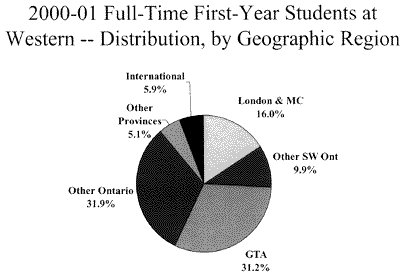
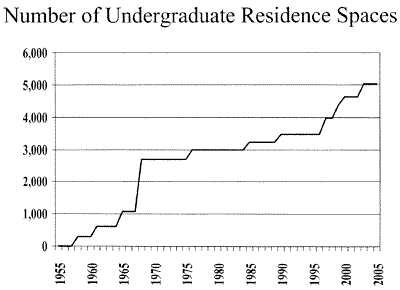

Looking forward to the period after the double cohort, Western plans to reduce the first-year intake at the Constituent University (i.e., excluding the Affiliated Colleges) to 4,350 in 2005-06. The years after the double cohort are forecast to be ones of slower growth for the system as a whole, and Western desires now to set a target for first-year enrolments for the post-double-cohort period. The Task Force proposes that our target for first-year enrolments be from 4,200 to 4,500 annually for the decade after 2004. Growth in enrolments will then be driven by the potential increase in undergraduate transfers of qualified students from community colleges and other universities, by the growing demand by students for four-year undergraduate programs, by a greater year-to-year retention rate due to the higher qualifications of incoming students and increased program satisfaction, and by increases in graduate student enrolment.
All of our enrolment forecasts are contingent on full funding at current levels for all additional students. Real per-student public operating funding in Canada has fallen by about 30% over the last two decades, a period when per-student funding increased in U.S. state universities by nearly 20%. The result has been a steadily growing student-faculty ratio in Canada which undermines contact between faculty and students and lowers the quality of the student experience. The Ontario university student-faculty ratio is now about 11.5% above the average in the other nine provinces and about 35% higher than the ratio in U.S. publicly-funded universities.
Related Charts:
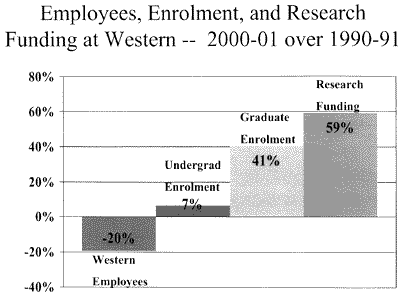
Quality of education is a key issue now among Ontario universities; we cannot give our students a quality of education competitive with North American standards without substantial increases in public funding. The announcement in the May 9, 2001 Provincial Budget of $220 million for enrolment expansion in universities over the next three years, which Western greeted positively, is a strong first step in reversing the increases in the student-faculty ratio. Ontario universities now need to work with the Province on an additional public investment which would allow both a reduction of 11.5% in the student-faculty ratio in Ontario, lowering it to the average of the other nine provinces, and a similar reduction of 11.5% in the student-staff ratio. We cannot provide our students with the quality of education they deserve unless we can improve significantly the balance between our faculty and staff numbers and our student numbers.
The University will maintain its traditions of fiscal responsibility, including the commitment to a balanced budget, in planning the annual Operating Budget. A key element in our response to constrained operating resources must be a continuing effort to make the very best use of the public and private funds which we administer. In administrative and ancillary operations, the University regularly benchmarks its performance against those of other universities and similar institutions. For example, in the area of purchasing, we belong to the Ontario University Purchasing Management Association (OUPMA), a consortium which not only seeks to lower costs through joint purchasing contracts, but benchmarks the cost of particular standard commodity groups at each of the universities. For purchasing operations, we use benchmarks from the Center for Advanced Purchasing Studies (CAPS) at Arizona State University. Western has traditionally performed very well in terms of these purchasing benchmarks. The University is committed to extending the use of benchmarking and other methods of management accountability to improve the efficiency of our administrative and ancillary operations. Our objective is to optimize the value received for each dollar spent in terms of the quality of our teaching and research, our service to our students, and our contribution to society.
Related Charts:
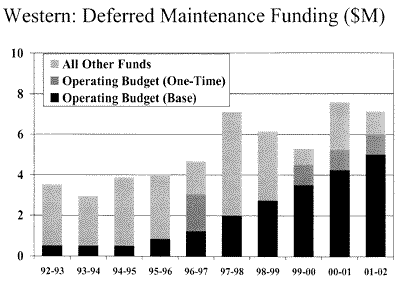
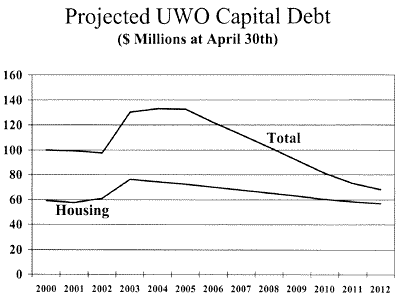
Full operating funding for additional students is also critical to our SuperBuild projects, which involve debt which Western intends to repay over the next decade, using a part of the increased public funding from the increased enrolment. We will seek to keep our new construction to the minimum required for high-quality education and the recruitment of outstanding new faculty members; the latter often require the provision of modern laboratory space. To reduce the need for new construction, we must make better use of our existing facilities by renovating older space and making more intensive use of teaching facilities over the entire day. In addition to utilizing the special grant in support of infrastructure at colleges and universities announced in the May 9, 2001 Ontario Budget, we will continue to increase budgetary transfers in support of deferred maintenance, as called for in our 1995 Strategic Plan, Leadership in Learning; Western’s commitment in this regard is unique among Canadian universities. We will also increase our private support, by reaching our goal of $270 million in Campaign Western, and then maintaining a high level of private giving after the conclusion of the Campaign. In today’s context, private giving has become essential in leveraging Provincial and Federal support for research and infrastructure.
Our Commitments:
9. Western will preserve its institutional character and identity by controlling overall enrolment growth and increasing enrolments strategically in areas where demand and capacity exist. Our University community will:
9.1 Adhere to enrolment targets as approved by Senate and the Board for the period 2001-2005;
9.2 Establish first-year enrolment targets of between 4,200 and 4,500 for the decade after 2005;
9.3 Expand graduate programs in areas of high quality and capacity;
9.4 Develop strategies for more appropriate, innovative and intensive use of existing space;
9.5 Continue to increase the transfer from the operating budget to the capital budget for deferred maintenance by $750,000 a year, until the annual transfer reaches $7.5 million;
9.6 Ensure that the Operational Plans and the annual planning documents of our administrative and ancillary units contain benchmarking measures and other measures of efficiency and performance;
9.7 Carry out successfully Campaign Western, by reaching the target of $270 million before April 30, 2004, and maintaining the flow of new gifts and pledges at a level above $40 million per year for the five years after the conclusion of the Campaign;
9.8 Seek broad public support for increases in public funding for Ontario universities which would allow the Province to achieve two objectives over the five-year period from 2001 to 2006: a reduction of 11.5% in the student-faculty ratio in Ontario, lowering it to the average of the other nine provinces, and a similar reduction of 11.5% in the student-staff ratio.
